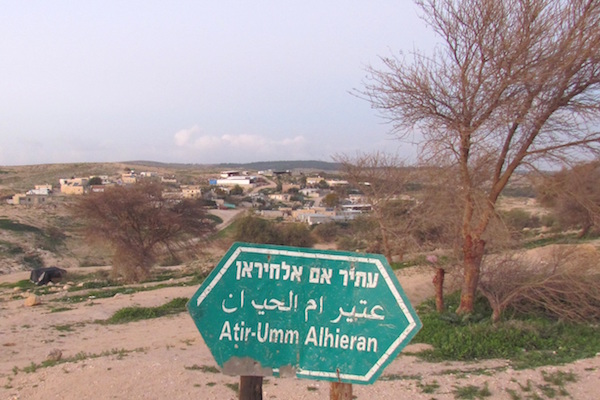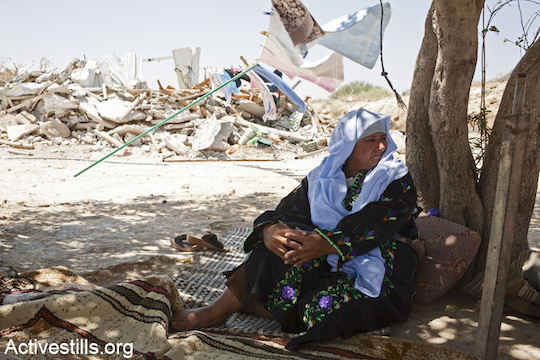As the Bedouin village of Umm al-Hiran prepares to be replaced by a Jewish town with a near-identical name, its residents are offering solutions based on real co-existence.
By Ariel Dloomy

In July 2007 I witnessed one of the saddest events of my life. Hundreds of security force personnel descended upon the Bedouin village of Umm al-Hiran in order to evict the residents and demolish their homes. The police removed cradles together with the infants while bulldozers razed the homes and uprooted olive trees from the yards. Dozens of Jewish youth hired by the demolition contractor loaded residents’ personal belongings into containers that were then transported from the area. When everything was packed up, the youth danced in front of the stunned residents while chanting, “this is the new Zionism.”
Eight years and many court hearings have passed, but the threat of demolition and eviction lingers over the residents’ heads. Currently, this threat is more tangible than ever after the High Court recently rejected the appeal of the community’s 700 residents. This decision enables the government to proceed with its plans to forcibly relocate the residents of Umm al-Hiran residents to the neighboring village of Hura, while building the Jewish town of Hiran atop the ruins of the old village. This decision was unaffected by the mayor of the Hura local council, who said that his village does not have room for the evicted residents. The residents’ claims that in 1956, the military governor of the area ordered the tribe to move to its current location, after it had already forcibly removed them from the area of Wadi Zubaleh, near Kibbutz Shuval.
Just a few kilometers from the village, where the Yatir Forest road begins, 25 Jewish families from the Hiran Group are living in a temporary camp, awaiting “final authorization” to settle on the land Umm al-Hiran. According to the group’s website, “the intention is to build a settlement designated for the national-religious community in the northern Negev Desert as part of establishing a continuity of Jewish settlements in the area.” These descriptions are in complete contradiction to the state’s claim to the High Court that the new settlement will be a “general” (non-denominational) one without unique characteristics, and will not be closed to any potential resident based on religious affiliation. Thus, once again, the story of Umm al-Hiran epitomizes the national-ethnic struggle over land and settlement in Israel.

In a minority opinion, Supreme Court Justice Dafna Barak-Erez writes:
The state did not take into consideration at all an additional important and even critical point, that the petitioners had been authorized to live on this land for tens of years. In this case, the state based its position on false information according to which the petitioners were trespassers. Even worse: the state did not reconsider its decisions when the true facts came to light. Moreover, it did not at all take into consideration the attachment that the authorized residents had developed for the place in which they were living. .. or the depth of the affront to them after the many years of their living on that site.
The High Court is one of the most important institutions in the State of Israel and its decisions must be honored. However, the question that must be critically examined is whether the Negev Bedouin are at all capable of succeeding in their legal battles over land rights within the Israeli legal system. This is a system that completely disregards their traditional methods of bequeathal, which continued during the periods of both the Ottoman and the British Empires; a system that expropriated the land from which the Bedouins had been evicted in 1951 through the passing of passing the Land Purchase Law in 1953; a system that circumvented the Bedouin villages when it passed the Building and Planning Law in 1965, and continued to abuse them with eviction notices, ongoing demolitions and insulting offers of compensation.
Within a few years the struggle over Umm al-Hiran will become embedded in the collective memory as the “Tel Hai” myth (considered to be the first major battle between pre-state Jewish settlers and Arab rebels, which later became part of the Zionist historical canon) of the Negev Bedouin: the few against the many, struggling over a piece of land in an isolated area while being unjustly attacked by forces more powerful than them. While it is true that there is a large gap between the myth of Tel Hai and the actual historical story, that is the nature of myths. To tell a story that will justify larger perceptions.
However, there exists an alternative solution. When I visited Umm al-Hiran again last week, the village sheikh was speaking to the residents. In an interesting step, he called for the establishment of a joint community together with Jews who are interested in living there. It now remains to be seen if Umm al-Hiran will become yet another national myth in the struggle between Arabs and Jews in this country. Perhaps it could also serve as a new model for cooperation between Arabs and Jews that will transform the crisis into a new opportunity, while sparking optimism for the future of the Negev.
Ariel Dloomy is Co-Executive director of AJEEC-NISPED, a Negev-based NGO that promote equality, empowerment and cooperation. This article was first published in Hebrew on Haokets.


